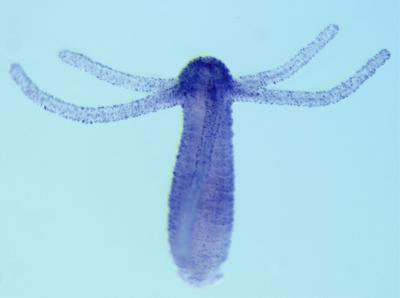Origin of Vision Discovered

You are reading these words right now because 600 million years ago, an aquatic animal called a Hydra developed light-receptive genes—the origin of animal vision.
It wasn't exactly 20-20 vision back then though.
Hydras, a genus of freshwater animals that are kin to corals and jellyfish, measure only a few millimeters in diameter and have been around for hundreds of millions of years.
Scientists at the University of California, Santa Barbara studied the genes associated with vision (called opsins) in these tiny creatures and found opsin proteins all over their bodies.
Though they don't have eyes or any specific light-receptive organs, researchers think that the light-sensing proteins concentrated in the mouth area of the Hydras help them to use light sensitivity to search out prey.
Because studies of animals that evolved earlier, such as sponges, don't show the same light sensitivity, scientists were able to pinpoint the Precambrian date that animal vision first started to evolve.
"We now have a time frame for the evolution of animal light sensitivity," said study leader David Plachetzki, a UC Santa Barbara graduate student. "We know its precursors existed roughly 600 million years ago.
Get the world’s most fascinating discoveries delivered straight to your inbox.
These findings, detailed in a recent issue of the online journal PLoS ONE, counter arguments by anti-evolutionists that evolution can only eliminate traits and cannot produce new features, the authors say.
“Our paper shows that such claims are simply wrong," said co-author Todd Oakley, also a UC Santa Barbara biologist. "We show very clearly that specific mutational changes in a particular duplicated gene (opsin) allowed the new genes to interact with different proteins in new ways. Today, these different interactions underlie the genetic machinery of vision, which is different in various animal groups.”
- Top 10 Amazing Animal Abilities
- Top 10 Useless Limbs (and Other Vestigial Organs)
- Images: Incredible Coral

Andrea Thompson is an associate editor at Scientific American, where she covers sustainability, energy and the environment. Prior to that, she was a senior writer covering climate science at Climate Central and a reporter and editor at Live Science, where she primarily covered Earth science and the environment. She holds a graduate degree in science health and environmental reporting from New York University, as well as a bachelor of science and and masters of science in atmospheric chemistry from the Georgia Institute of Technology.


